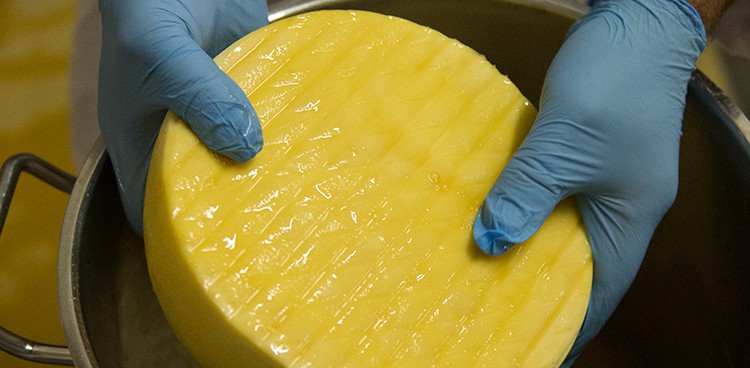
If you are at all like me, then a headline with beer and cheese paired so closely together already has your mouth watering and your imagination running. Don’t do anything rash with that cheese stick and can of PBR though; beer-washed rind cheeses aren’t quite so simple. A prime example of stinky cheese, the scent is commonly described as a cross between “bare-feet” and “barnyard.” The flavor is milder, and the influence of beer is usually only present in hoppy overtones. This is the closest approximation to a bluegrass band that you’ll find in the cheese world. Unlike any of these, though, this is a cheese worth hearing out.
Humble Beginnings: A Monk-y Cheese
In 1892, Thomas Edison patented the lightbulb, David T. Abercrombie opened his first store, and the now-world-famous Trappist Monks broke off from the ancient Cistercian branch. Trappists were originalists, and they closely followed the dictums of the 6th-century monk St. Benedict. One of these teachings was to “live by the work of their hands,” so, naturally, they made beer. It wasn’t long after that they realized the importance of pairing, and they started making cheese too. Never to miss a creative opportunity, they added beer to the brine in which they washed their unripened cheeses. This lent a unique flavor and started a particularly tasty genre of cheese. If stinky cheese isn’t quite your thing, Trappists are also famous for their beer, Westvleteren 12, which is considered by many to be the best beer in the world.
But How Does it Work?
With some variations in the specifics, the same process is used to transform milk into the savory product we know and love. Depending on the temperatures at which you incubate bacteria and the amount of moisture and whey you drain off, cheese becomes either hard or soft. Soft cheeses are ripened from the surface, which means that the bacteria activity that gives the cheese its flavor happens from the outside in. Some surface-ripened cheeses are treated with a brine before ripening. This controls the bacteria growing on your cheese so that only Brevibacterium linens, the desired ripening agent, prospers. In this case, beer is added to the brine, which influences the flavor during maturation. Washed-rind cheeses have a durable rind that retains moisture. B. linens removes traces of acidity and leaves an intriguingly pungent product.
I’m Sold. Now What?
While the Trappists used their own beer in the production process, most cheesemakers today don’t have the same vertical integration. This provides the opportunity for some great partnerships. If you happen to see the label of your favorite porter at your local monger, make sure you pick up a wedge!
For a classic taste, try Chimay, which is brewed at the Abbey of Notre-Dame de Scourmont in Chimay, Belgium—the ancestral homeland of beer-washed cheeses. The cheese matures into a semisoft, supple, and slightly springy texture with that trademark pungent aroma. The repeated washings turn the rind red-orange and slightly sticky.
For something closer to home, look to Good Thunder by Minnesota’s Alemar Cheese. This cute little square is washed with brine and Surly Brewing Co.’s Bender beer, an oatmeal brown ale that’s also from the Land of 10,000 Lakes.
And although now washed entirely in a brine solution, it’s worth noting that Jasper Hill Farm‘s< Winnimere was originally washed in a lambic-style beer brewed on the premises (featured in our very first issue!). This spruce-bark-wrapped beauty is best consumed with a spoon after peeling away the top layer, offering an immense variety of flavors—from mustard to bacon to almonds to grass.
Pair your favorite beer-washed cheese with something hearty enough to keep up with it. A fruity red wine, a selection of cured meat, or your favorite stout/IPA all go well with these rounds and wheels.

A cheesemaker washes wheels of Winnimere with a brine solution mixed with a home-brewed lambic-style beer (2008).
And Finally,
Trappist monks are not some long forgotten sect—they still practice the Rule of St. Benedictus, just like their founding fathers. Though no longer on the cheese vanguard, here are some choice words from their website to leave you in the rustic frame of mind common to all stinky cheeses:
“We remember the gentle rhythms of prayer chants, the scent of a well oiled tractor rolling through fresh cut fields, the way aged wooden floorboards retain the smell of burnt incense, the heaviness of weary legs stretched out on a simple hardwood bed prepared with fresh laundered sheets. It is remarkable how swiftly the days pass in a monastery. At days end, a last bell is heard whose music delights for a moment and passes away.”




